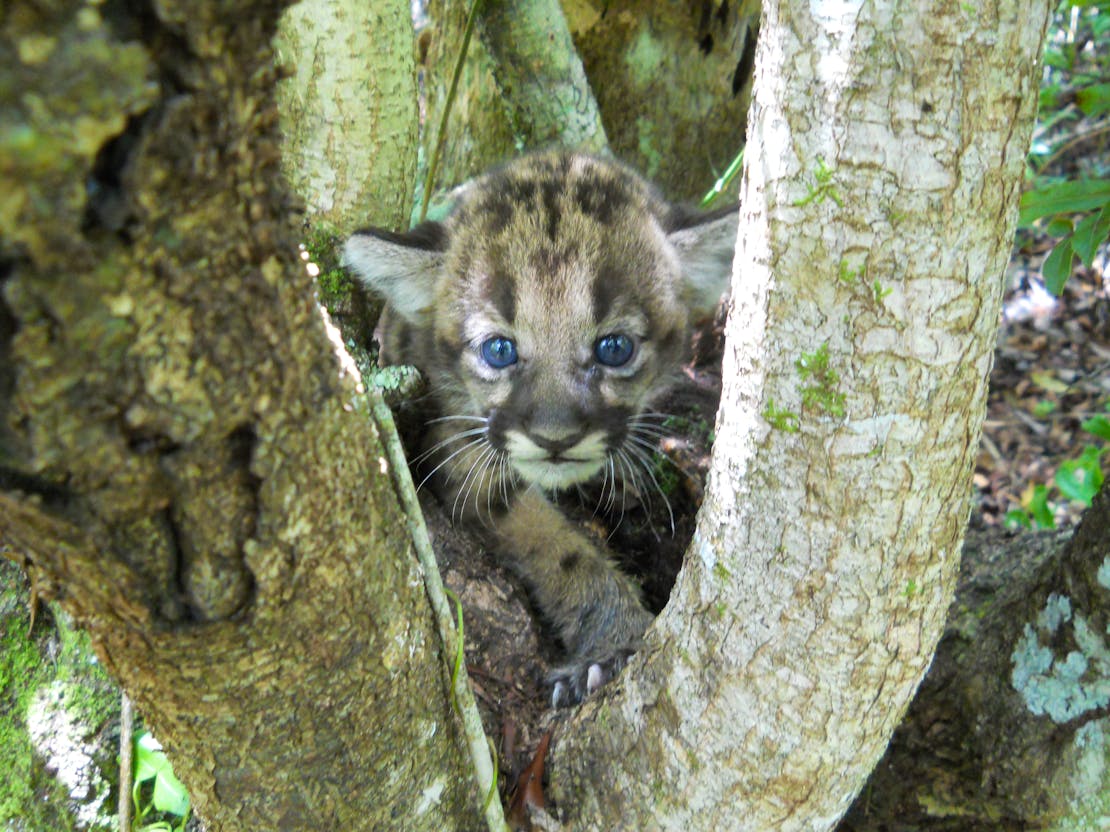Join our mobile Rapid Response Network!
You can be the first to hear about how we’re going to hold the next administration accountable and how you can fight back for wildlife!
The Florida panther is the only puma (also known as cougar and mountain lion) population east of the Mississippi.
Florida panthers once prowled and flourished in woodlands and swamps throughout the Southeast. When European settlers arrived in the 1600s, the clear-cutting, building and other human activities that destroy, degrade and fragment habitat began, and the fear and misconceptions that led to panther persecution took root. Today, the panther is recognized as Florida’s official state animal, but it is also one of the most endangered mammals in the country.
Panthers are an umbrella species: protecting them and the vast, unspoiled, wild territory each one needs to survive - an average of 200 square miles for a single male - protects many other plants and animals that live there. At the top of the food chain, these cats help keep feral hog numbers in check and deer, raccoon and other prey populations balanced and healthy.
Habitat loss, fragmentation and degradation are the major threats to panther survival.
Roadway mortality, which limits range expansion, is the largest human cause of panther deaths — dozens of panthers are killed on roads every year while searching for territory, food and mates (a record 34 were killed crossing roads in 2016).
Lack of landowner acceptance can threaten recovery.
The small size and high degree of isolation of the panther population makes it vulnerable to genetic problems and catastrophic events such as disease, parasite outbreaks and exposure to toxins. A fatal neuromuscular disorder first observed affecting panthers and bobcats in 2018 is of particular concern as it is poorly understood and more widespread than previously thought.

Defenders' Impact
Defenders of Wildlife’s efforts to help the Florida panther survive started more than four decades ago when we lobbied for its inclusion under the federal Endangered Species Act. We have been fighting for panthers ever since — to secure and protect the large interconnected tracts of wild land they need to expand their range northward, to foster understanding of these wide-ranging and secretive predators and to address a leading cause of panther deaths: collisions with vehicles while attempting to cross roads.
In recognition of our longstanding commitment to panther recovery, Defenders serves as the conservation representative on the federal Florida Panther Recovery Implementation Team.
Through partnerships, education, research support, public outreach, and advocacy, Defenders is working to foster understanding of Florida panthers and to help people share the landscape with these endangered predators.
We launched our Florida panther coexistence program in 2004 to respond to an increase of panther depredations on livestock and pets.
In rural neighborhoods, we help fund and construct sturdy enclosures to protect pets and small livestock from panthers and other predators to avoid conflict. Since 2010, there has been an uptick in panthers preying upon calves in commercial ranching operations. The predator-resistant enclosures that we use in rural neighborhoods are not applicable to these larger landscapes, so we are working with ranchers and other members of the Panther Recovery Team to improve incentive programs to help offset monetary losses when panthers kill commercial livestock.
You can be a part of the solution for endangered species: support our efforts to protect the wild!
What You Can Do
If you live in panther country, practice proven coexistence techniques. Slow down and watch the roads for panthers if you are driving through panther habitat.
Support Defenders' work in panther recovery.

About
Panthers historically ranged across the southeastern United States including Arkansas, Louisiana, Mississippi, Alabama, Georgia, Florida, and parts of Tennessee and South Carolina. Now, the breeding population of Florida panthers is found only in the southwestern tip of Florida. Since 2016 – for the first time since the 1970s – a few females with kittens have been documented north of the Caloosahatchee River. Panthers are habitat generalists, which means they use a variety of habitat types, including forests, prairies and swamps.
There are an estimated 120-230 adults and subadults primarily in southwest Florida, the only breeding population. Continued northward range expansion and restoration of additional populations are recognized as essential for panther recovery.
They are solitary and territorial animals that travel hundreds of miles within their home ranges. Panthers are mostly active between dusk and dawn, resting during the heat of the day.
Rarely do all kittens survive. Kittens are born with dark spots that soon fade away as they become adults, which are tawny brown (the color of deer ) . They stay with their mother for up to two years.
Mating Season: Throughout the year, with a peak in winter/spring
Gestation: About 90 days
Litter Size: 1-4 kittens
Florida panthers are carnivores and primarily eat white-tailed deer, but they will also hunt feral hog, rabbit, raccoon, armadillo, birds and other animals.
Featured
Coexisting with Florida Panthers
With Florida experiencing ever-increasing development that often places humans and panthers in proximity, the future of the panther depends upon our ability to coexist.
News

Defenders Statement on 2024 Florida Panther Road Deaths










